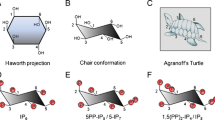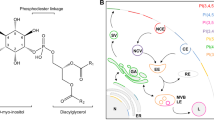Abstract
Accumulations of higher inositol polyphosphates, diphosphoinositol polyphosphates or pyrophosphates, have been implicated to mediate cellular apoptosis. Whether cellular levels of lower inositol phosphates (lower than inositol hexakisphosphates) change during apoptosis is not known, although these inositol phosphates are known to play crucial roles in a number of cellular signaling processes including calcium mobilization. Therefore, in this study, we have examined changes in cellular levels of inositol phosphates following metabolic labeling of these compounds by [3H]myo-inositol and induction of apoptosis. The levels of inositol mono- and bis-phosphates were increased, whereas the levels of inositol tris- and tetrakis-phosphates decreased significantly with an increasing rate of apoptosis induced by etoposide in a dose-dependent manner. NaF treatment, which increased the rate of apoptosis in a time- and dose-dependent manner, also increased the levels of inositol mono- and bis-phosphates and drastically reduced the levels of inositol tris- and tetrakis-phosphates. Prior treatment with antimycin A, a strategy used to reverse the NaF-induced accumulations of higher InsPs, partially reduced the effects of NaF on apoptosis as well as the levels of lower InsPs. Taken together, our results suggest that cellular levels of lower InsPs are altered during apoptosis.





Similar content being viewed by others
Abbreviations
- MEM:
-
Minimum essential medium
- FBS:
-
Fetal bovine serum
- PH:
-
Pleckstrin homology domain
- InsPs:
-
Inositol polyphosphates
- PIP:
-
Phosphatidlylinositol phosphates
- AKT/PKB:
-
Protein kinase B
- PI-3K:
-
Phosphatidylinositol 3-kinase
- DAB:
-
Diaminobenzidine
References
Berridge MJ, Irvine RF (1989) Inositol phosphates and cell signaling. Nature 341:197–205
Brini M, Carafoli E (2000) Calcium signalling: a historical account, recent developments and future perspectives. Cell Mol Life Sci 57:354–370
Shears SB (1989) Metabolism of the inositol phosphates produced upon receptor activation. Biochem J 260:313–324
Menniti FS, Miller RN, Putney JW Jr, Shears SB (1993) Turnover of inositol polyphosphate pyrophosphates in pancreatoma cells. J Biol Chem 268:3850–3856
Shears SB, Ali N, Craxton A, Bembenek ME (1995) Synthesis and metabolism of bis-diphosphoinositol tetrakisphosphate in vitro and in vivo. J Biol Chem 270:10489–10497
Morrison BH, Bauer JA, Kalvakolanu DV, Lindner DJ (2001) Inositol hexakisphosphate kinase-2 mediates growth suppressive and apoptotic effects of interferon-beta in ovarian carcinoma cells. J Biol Chem 276:24965–24970
Ferry S, Matsuda M, Yoshida H, Hirata M (2002) Inositol hexakisphosphate blocks tumor cell growth by activating apoptotic machinery as well as by inhibiting the Akt/NFB-mediated cell survival pathway. Carcinogenesis 23:2031–2041
Piccolo E, Vignati S, Maffucci T, Innominato PF, Riley AM, Potter BV, Pandolfi PP, Broggini M, Iacobelli S, Innocenti P, Falasca M (2004) Inositol pentakisphosphate promotes apoptosis through the PI 3-K/Akt pathway. Oncogene 23:1754–1765
Saiardi A, Resnick AC, Snowman AM, Wendland B, Snyder SH (2005) Inositol pyrophosphates regulate cell death and telomere length through phosphoinositide 3-kinase-related protein kinases. Proc Nat Acad Sci USA 102:1911–1914
Nagata E, Luo HR, Saiardi A, Bae B II, Suzuki N, Snyder SH (2005) Inositol hexakisphosphate kinase-2, a physiologic mediator of cell death. J Biol Chem 280:1634–1640
Majerus PW, Zou J, Marjanovic J, Kisseleva MV, Wilson MP (2008) The role of inositol signaling in the control of apoptosis. Adv Enzyme Regul 48:10–17
Agarwal R, Mumtaz H, Ali N (2009) Role of inositol polyphosphates in programmed cell death. Mol Cell Biochem 328:155–165
Ali N, MacLeod S, Hine RJ, Chowdhury P (2009) Cellular signaling mechanisms in pancreatic apoptosis. In: Chen GG, Lai PBS (eds) Apoptosis in carcinogenesis and chemotherapy. Springer, Netherlands, pp 295–325
Vucenik I, Shamsuddin AM (2006) Protection against cancer by dietary IP6 and inositol. Nutr Cancer 55:109–125
Kolappaswamy K, Willams KA, Benazzi O, Sarli G, McLeod CG, Vucenik I, Detolla LJ (2009) Effect of inositol hexaphosphate on the development of UVN-induced skin tumors in SKM1 hairless mice. Comp Med 59:147–152
Raina K, Rajamanickam S, Singh PR, Agarwal R (2008) Chemopreventive efficacy of inositol hexaphosphate against prostate tumor growth and progression in TRAMP mice. Clin Cancer Res 14:3177–3184
Pesesse X, Choi K, Zhang T, Shears SB (2004) Signaling by higher inositol polyphosphates: hyperosmotic stress acutely and selectively activates synthesis of bis-diphosphoinositol tetrakisphosphate (“InsP8”). J Biol Chem 279:43378–43381
Graff I, Mockel J, Laurent E, Erneux C, Dumont JE (1987) Carbachol and sodium fluoride, but not TSH, stimulate the generation of inositol phosphates in the dog thyroid. FEBS Lett 210:204–210
Ho MWY, Kaetzel MA, Armstrong DL, Shears SB (2001) Regulation of a human chloride channel: a paradigm for integrating input from calcium, CaMKII and Ins(3, 4, 5, 6)P4. J Biol Chem 276:18673–18680
Ali N, Craxton A, Sumner M, Shears SB (1995) Effects of aluminium on the hepatic inositol polyphosphate phosphatase. Biochem J 305:557–561
Anuradha CD, Kanno S, Hirano S (2001) Oxidative damage to mitochondria is a preliminary step to caspase-3 activation in fluoride-induced apoptosis in HL-60 cells. Free Radic Biol Med 31:367–373
Thrane EV, Refsnes M, Thoresen GH, Lag M, Schwarze PE (2001) Fluoride-induced apoptosis in epithelial lung cells involves activation of MAP kinase p38 and possibly JNK. Toxicol Sci 61:83–91
Acknowledgments
This study was supported in part by funds from the Graduate Institute of Technology, Arkansas Space Grant Consortium and Arkansas NSF-EPSCoR P3 grant. R. Agarwal and S. Hassen thank the Graduate Institute of Technology for Graduate Assistantships. Authors would like to thank Ms. Diane Haynes for grammatical editing of the manuscript.
Author information
Authors and Affiliations
Corresponding author
Rights and permissions
About this article
Cite this article
Agarwal, R., Hassen, S. & Ali, N. Changes in cellular levels of inositol polyphosphates during apoptosis. Mol Cell Biochem 345, 61–68 (2010). https://doi.org/10.1007/s11010-010-0560-0
Received:
Accepted:
Published:
Issue Date:
DOI: https://doi.org/10.1007/s11010-010-0560-0




